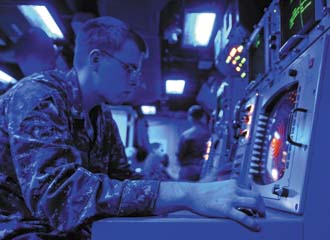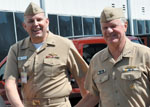Digital Navy Poised to Set Sail
 |
A sailor aboard the USS Essex tests a radar display in the ship’s combat information center. The U.S. Navy’s Space and Naval Warfare Systems Command, or SPAWAR, is striving to ensure that the Navy’s sensors and systems operate seamlessly across the network. |
The U.S. Navy is steaming full speed toward attaining its dream of a digital force, but the most difficult part of the journey may lie just ahead. The sea service has its technological map, and its course has the endorsement of the top leadership. However, it must deal with a new set of challenges as its info-centric force evolves into a new form.
Navy command, control, communications, computers and intelligence (C4I) is defining fleet capabilities to an ever-increasing degree. The chief of naval operations (CNO), Adm. Gary Roughead, USN, has declared information dominance his main goal. Accordingly, the Navy is striving to maintain the same degree of supremacy in cyberspace that it has throughout the world’s maritime environment.
But achieving those goals will require surmounting obstacles that are as much a result of success as they are of technological problems and geopolitical adversaries. Advances in intelligence, surveillance and reconnaissance require greater networking capabilities. The ongoing revolution in information technology mandates that the Navy incorporate advances into the fleet without interfering with existing capabilities. And, cyberspace operations must be defended against an ever-increasing threat.
The U.S. Navy’s Space and Naval Warfare Systems Command (SPAWAR) is at the technological forefront of much of the Navy’s information technology thrust. Its commander, Rear Adm. Patrick H. Brady, USN, declares that information dominance is SPAWAR’s top priority. With every Navy platform carrying multiple sensors, and with every sensor and processor connected to the network, then every shooter and weapon must be capable of using target data derived from any collection element seamlessly, the admiral states.
Adm. Brady lists three themes on which he is focusing since assuming command a few months ago. The first is to ensure a lack of seams between the various elements of SPAWAR. He explains that, as the command addresses diverse issues for the Navy, it must understand fully all the issues that may emerge as it formulates its solutions.
The second theme involves efficiency “from a larger Navy point of view.” This entails improving efficiency for individuals as well as organizations within the Navy, he explains. The effort spans disciplines ranging from network configurations and operations to training.
And, the third theme focuses inward on SPAWAR. With the Navy’s thrust on information dominance (SIGNAL Magazine, December 2009), Adm. Brady sees SPAWAR serving as the “Navy’s information dominance systems command” that makes the information dominance vision a reality.
To follow through on those three themes, the admiral has issued five taskers. His first involves putting the Navy’s program of record C4I systems on new construction platforms. The admiral relates that he has received considerable feedback on the need to improve SPAWAR’s ability to work across the various Navy systems commands to find innovative ways of developing these new systems without negatively affecting the new platforms’ costs and schedules.
“If we can deliver a Navy program of record system, vice adding another nonstandard C4I system and configuration for the fleet, we can address total ownership costs and also minimize the training, maintenance and interoperability burdens on our fleet,” he says.
Another goal is to find ways of adding a new capability to an existing program of record instead of developing that capability in a completely new effort, which would help save on research and development. The command also will seek opportunities for quantity buys that help control costs.
The command will be assessing systems already in the fleet that have not been programs of record. The goal is to bring these nonstandard systems into the support realm. This could involve some of the LPD-17/San Antonio-class systems and littoral combat ship (LCS) systems, he suggests.
Maintaining and modernizing C4I systems constitutes the admiral’s second tasker. SPAWAR is looking at the process of maintenance reports, particularly to improve rapid response. Modernizing translates into SPAWAR developing and delivering its products, and the command has assembled a team to examine challenges in that arena. That team already has assembled a prioritized list of initiatives that can be implemented in the near term.
The admiral’s third tasker involves C4I governance and technical authority. The goal is a single organization that provides the necessary technical guidance and authority for C4I in enterprise systems, the admiral explains. He adds that this is important for having a clearly defined authority with common technical standards, interoperability test processes and a certification process along with a governance body to resolve issues. Having this authority also will help eliminate seams between the other Navy system commands.
 |
SPAWAR commander Rear Adm. Patrick H. Brady, USN (l), talks with the U.S. Navy chief of naval operations (CNO), Adm. Gary Roughead, USN, during the CNO’s visit to SPAWAR in September. SPAWAR is directing significant effort to ensuring that the Navy can attain the CNO’s goal of information dominance. |
“One, we’re trying to address some really high-priority issues that the 10th Fleet has out there, and how can we bring our technical acquisition experience into their lineup,” Adm. Brady says. “The other one, as we look out to the future and be able to affect the budget process, is to propose common approaches that could be used across the Navy networks.” These approaches would encompass network visibility and instrumentation, computer network defense and then network responses, he says, adding that the command has made progress in focusing on those three aspects. “The work with our technical expertise that we’re synching up with 10th Fleet priorities is going well,” he says.
Supporting cyber operations is a key part of SPAWAR’s mission. Adm. Brady relates that he recently met with Vice Adm. Barry McCullough, USN, commander of the 10th Fleet (see page 18), to discuss SPAWAR’s efforts in the cyber realm. Adm. Brady believes that the command is doing well supporting the 10th Fleet, but Adm. McCullough wants the command to supply software patch updates to the afloat networks more rapidly. Adm. Brady offers that SPAWAR has made good headway in that endeavor.
SPAWAR first is focusing on ensuring reliable, accessible and secure networks. The Next Generation Enterprise Network, or NGEN, and the Consolidated Afloat Network Enterprise Services (CANES) program are a foundation of that focus, the admiral notes.
The N-2/N-6 realignment has had a significant effect on SPAWAR’s activities. Adm. Brady relates that 90 percent of the funding into the command’s program executive offices (PEOs) comes from the new organization. “I view the N-2/N-6—through the requirements [Vice Adm. David J. Dorsett, USN, N-2/N-6] has laid out and the way he is executing the CNO’s information dominance vision—as the key requirements individual who lays out the path of how we’re going to make this information dominance vision a reality,” Adm. Brady declares.
The fifth tasker is to instill “cultural efficiency from a larger Navy point of view,” which matches the admiral’s second theme item. The command is establishing a standard efficiency performance objective for each SPAWAR member, he offers.
That cultural efficiency includes ensuring that Navy personnel exploit new technologies to the best of their abilities—along with the systems’ capabilities. “We want to make sure that, when we deliver systems to the fleet, the 20-year-old sailors are able to operate those systems in a world-class fashion,” the admiral offers. “So, we need to make sure, when we deliver our various systems, that we’ve delivered a system with the training, the maintenance and the reliability so that our operators can be world-class operators.”
That task has become more difficult as systems have become more complex, the admiral observes. With the Navy becoming more enmeshed with systems of systems, the service must view its systems in a new light. This involves processes ranging from design and development through test, certification and maintenance. Viewing new systems in this manner at these stages is a top challenge for SPAWAR, Adm. Brady says.
This effort is complicated by the fact that SPAWAR does not produce every single Navy information technology system. So, the command must work with other groups, such as the Naval Sea Systems Command, in a cross-naval systems command interface.
To help SPAWAR achieve these goals, industry must provide technologies that can be operated by sailors without extraordinary training and education, Adm. Brady says. So, SPAWAR has laid out some architectures and road maps so that industry can fit its ideas into those guidelines.
Capabilities must be service-oriented for building more flexible, adaptable, distributed computing environments. Process improvements from private industry that increase efficiencies or reduce development costs are highly sought after, the admiral adds.
If SPAWAR is successful, then the next 10 years will see a realization of the CNO’s information dominance vision in which “information is a main battery of U.S. Navy warfighting capability,” Adm. Brady offers. Attaining this goal will be the measurement of SPAWAR’s success, he states.
In this realm, every platform will have multiple sensors, every sensor and processor would be connected to the network, and every shooter and weapon would be capable of seamlessly using target data derived from any collector or sensor.
Ships will have a common computing environment, and the Navy will have converged to a single network along the lines of the Naval Networking Environment 2016 strategic document. The Navy also will have instant and predictive network visibility.
WEB RESOURCE
SPAWAR: www.public.navy.mil/spawar



Comment
The transition from network
Comments